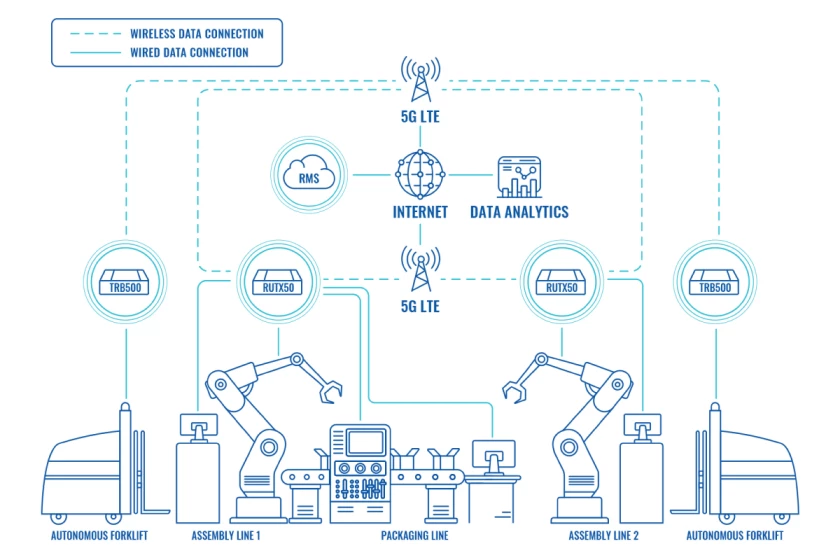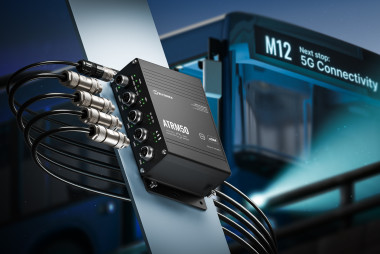5G Digitization in Manufacturing
#webinar, #ericsson, #manufacturing, #5g
The combination of 5G networks in industrial IoT and advanced analytics is opening up new opportunities for manufacturers to optimize their processes, reduce costs, and increase productivity. As different subsets of the manufacturing sector mature for the use of 5G networks, with some already benefitting from it, understanding the ins and outs of 5G digitization is key.

Teltonika Networks recently hosted a joint webinar with Ericsson that dived deep into this topic. Our Operational Marketing Project Executive, Pranas Aksamitauskas, and Ericsson’s Device Ecosystem Director, Micael Hermansson, discussed the limitations of 4G networks in manufacturing and the rapid adoption of 5G networks.
The webinar was recorded, so you can watch it now! But if you prefer reading into the topic in more detail, this article will do exactly that.
THE LIMITATIONS OF 4G NETWORKS IN MANUFACTURING

As Micael explained in the webinar, the need for 5G digitization begins with the limitations of 4G in meeting the sector’s growing demand for automation, remote capabilities, throughput, and enhanced security. To meet this demand, a network must deliver on three core elements.
1. Reliable Low Latency
Manufacturing requires reliable low latency, as even a slight delay can result in lost productivity, increased costs, and reduced efficiency. For example, in an assembly line, a delay in the transfer of product specifications or production data can lead to bottlenecks and downtime, which can be costly for the company.
A reliable network with low latency helps ensure that data is transferred quickly and efficiently, minimizing delays and downtime. This enables manufacturing companies to operate their facilities at maximum capacity and improve overall productivity.
2. Maximum Coverage
Maximum coverage is also important in manufacturing, where machines and systems are often spread out over a large area. A network with maximum coverage ensures that all machines and systems can be connected to the network, regardless of their location. This is essential for monitoring and controlling production processes remotely and ensuring that machines and systems are operating efficiently.
Additionally, maximum coverage is important for supporting mobile devices, such as tablets and smartphones, which are increasingly used in manufacturing for data collection and analysis. A network with maximum coverage ensures that employees can access the network from anywhere in the facility, improving efficiency.
3. Secure and Flexible Network
Manufacturing companies deal with sensitive information, such as intellectual property, product specifications, and customer data, on a daily basis. As a result, a secure network is critical to protecting this valuable information. A secure network helps prevent unauthorized access, data breaches, and cyberattacks, which can have serious consequences for the company's reputation, financial stability, and even legal liability.
In addition, a flexible network is essential in manufacturing, where changes in production processes and requirements are common. A flexible network can adapt to changes in demand, capacity, and workflow – allowing the company to quickly respond to market conditions and customer needs.
While 4G networks can provide some of these benefits, they are not designed to handle the growing demands of a modern manufacturing facility. 4G networks have limited bandwidth and high latency and are prone to network congestion, which can lead to dropped connections and slow data transfer speeds. This can have a significant impact on productivity and efficiency.
ENTER: 5G DIGITIZATION

5G digitization refers to the process of using 5G networks and digital technologies to transform industries and businesses. 5G digitization involves the use of advanced digital technologies such as AI, machine learning, IoT, cloud computing, and edge computing to enable new applications and services.
If 4G can no longer meet the demand for automation, remote capabilities, throughput, and enhanced security, let’s see what 5G brings to the table for the same three core elements.
1. Reliable Low Latency
5G digitization provides reliable low latency by using technologies such as edge computing and network slicing. Edge computing enables data processing to be performed closer to the source, reducing the time it takes for data to travel across the network. Network slicing enables the creation of dedicated network slices for specific applications or users, ensuring that each slice has the appropriate Quality of Service (QoS) parameters for low latency.
For example, in an assembly line, the use of edge computing and network slicing can reduce the latency between machines and systems, improving overall productivity and efficiency.
2. Maximum Coverage
5G digitization provides maximum coverage by using technologies such as small cells and massive MIMO. Small cells are low-power, short-range radio access points that can be placed throughout a manufacturing facility to provide coverage in areas where traditional cell towers cannot reach. Massive MIMO is a technology that uses multiple antennas to transmit and receive signals, improving coverage and capacity.
For example, in a large manufacturing facility, small cells can be placed throughout the facility to provide coverage in areas where traditional cell towers cannot reach. Massive MIMO can be used to improve coverage and capacity in areas with high network traffic, such as production lines or warehouses.
3. Secure and Flexible Network
5G digitization enables manufacturing companies to create a secure and flexible network by using virtualization and network slicing technologies. Network slicing enables the creation of virtual networks that are tailored to specific applications or users, providing a high level of security and flexibility.
For example, a manufacturing company can create a dedicated network slice for a specific production line, with its own QoS parameters and security protocols. This ensures that sensitive production data is protected, while also allowing for changes to be made to the network quickly and easily.
In addition, virtualization allows multiple virtual networks to run on the same physical infrastructure, improving resource utilization and reducing costs. This enables manufacturing companies to create a network that is both secure and flexible, while also being cost-effective.
EXAMPLES OF MANUFACTURING USE CASES UTILIZING 5G

Teltonika Networks is no stranger to manufacturing IIoT use cases, especially ones involving Industry 4.0. In the webinar with Ericsson, Pranas presented two use cases that showcase how 5G benefits manufacturing.
1. Boring and Milling Equipment Connectivity
The first use case came from a Teltonika Networks client that manufactures horizontal boring and milling machines. These machines are equipped with our TRB500 5G industrial gateway, which enables remote control and support capabilities. These allow an engineer to manage or provide support to multiple machines at once without being in the same physical location as the machines.
This is far more efficient than what a 4G network could offer. The lower latency, reduced downtime, improved reliability, and real-time communication provided by the TRB500’s 5G network helped save a great deal of time and operational costs.
2. Smart Factory Connectivity
The second use case is more complicated. In automated IoT solutions, machinery and equipment are connected together into one functioning system. This requires more connected devices and a growing scale of automation in order for the manufacturing process to increase not only in efficiency and output – but also in size.
For such an autonomous system, 4G speed simply isn’t enough. Luckily, 5G networks can transfer data up to 100 times faster. This means smart manufacturing devices can communicate with each other in real time, which enables faster decision-making and response time. The lower latency of a 5G network allows for more precise and efficient control of the manufacturing process, while 5G network capacity lets you expand the scale of connected devices and, as such, of your manufacturing operations.
In this particular use case, the TRB500 provided connectivity to moving equipment such as autonomous vehicles. Meanwhile, our RUX50 industrial 5G router provided connectivity to the stationary parts of the system, such as assembly line robot arms.
CONCLUSION
5G technology offers significant benefits to the digitalization of manufacturing processes, including faster and more reliable communication between devices and machines, real-time coordination and control of manufacturing processes, and improved productivity and efficiency.
By utilizing 5G networks, manufacturers can optimize their operations, reduce costs, and stay competitive in a rapidly-changing business landscape.
Choosing the right 5G networking device and connectivity solution is no easy task, but this process can be simplified with the right partners. At Teltonika Networks, our experts would be more than happy to help you, so feel free to contact us and make this challenging process much simpler.


